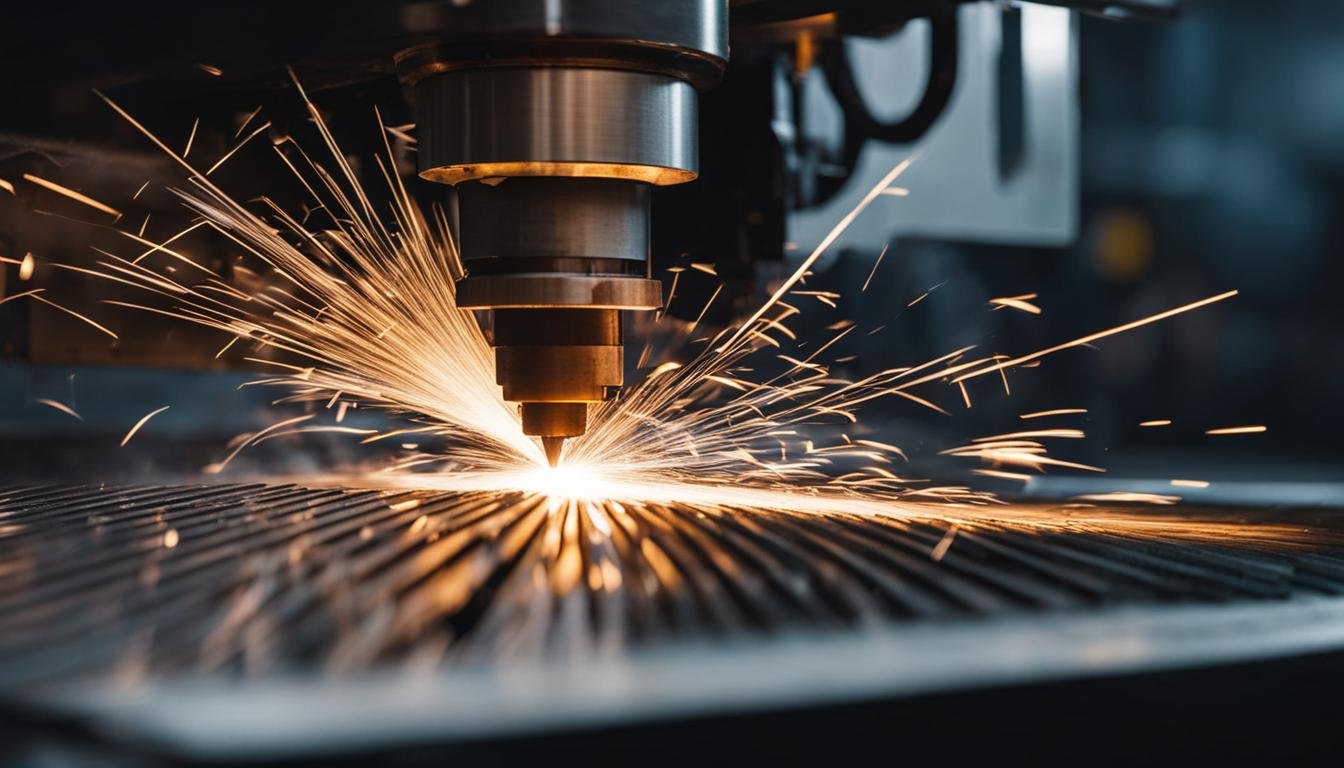Welcome to the fascinating world of CNC cutting! If you’ve ever wondered what CNC cutting is all about, you’ve come to the right place. CNC cutting, also known as Computer Numerical Control cutting, is a revolutionary manufacturing process that utilizes automated machines to shape and form components with unmatched precision. By harnessing the power of technology, manufacturers can achieve incredible accuracy and efficiency in their machining processes.
Key Takeaways:
- CNC cutting, or Computer Numerical Control cutting, is a manufacturing process that uses automated machines for precise component shaping.
- By following CNC cutting programs, manufacturers can optimize efficiency and achieve high-quality results.
- Components of CNC cutting programs include G-code, toolpath generation, feedrate and spindle speed, and tool compensation.
- Creating a CNC cutting program involves designing, modeling, using CAM software, and post-processing.
- Best practices for CNC cutting programs include optimization techniques, error handling, and staying up-to-date with advancements.
The Importance of CNC Cutting Programs
CNC cutting programs play a crucial role in the world of CNC machining, enabling precise and efficient manufacturing processes. These programs, also referred to as Computer Numerical Control cutting programs, guide automated machines to execute accurate operations with the utmost precision. By utilizing CNC cutting programs, manufacturers can achieve superior results compared to traditional manual methods. Whether in the automotive, aerospace, or medical industry, the importance of CNC cutting programs cannot be overstated in achieving the desired quality and efficiency in precision manufacturing.
One of the key advantages of CNC cutting programs is their ability to significantly increase efficiency and accuracy in the machining process. By eliminating the need for manual operation and relying on automated machines, manufacturers can achieve consistent and repeatable results, minimizing human error. This level of precision is especially crucial in industries that require intricate components and tight tolerances, ensuring that every product meets the highest standards of quality.
CNC cutting programs also offer flexibility and versatility in manufacturing. With the ability to easily modify and optimize programs, manufacturers can quickly adapt to changing requirements and design iterations. This flexibility allows for rapid prototyping and efficient production, reducing lead times and costs associated with traditional manufacturing methods. Furthermore, CNC cutting programs can be programmed to work with a wide range of materials, including metals and plastics, making them suitable for various applications across different industries.
The Advantages of CNC Cutting Programs:
- Increased efficiency and accuracy in manufacturing processes
- Consistent and repeatable results, minimizing human error
- Flexibility and versatility in adapting to changing requirements
- Reduced lead times and costs associated with traditional manufacturing
- Compatibility with a wide range of materials for diverse applications
In conclusion, CNC cutting programs are essential tools in precision manufacturing industries. Their ability to guide automated machines with precision and efficiency revolutionizes the way components are produced. By harnessing the power of CNC cutting programs, manufacturers can achieve superior results, reduce costs, and meet the increasing demands of their industries.
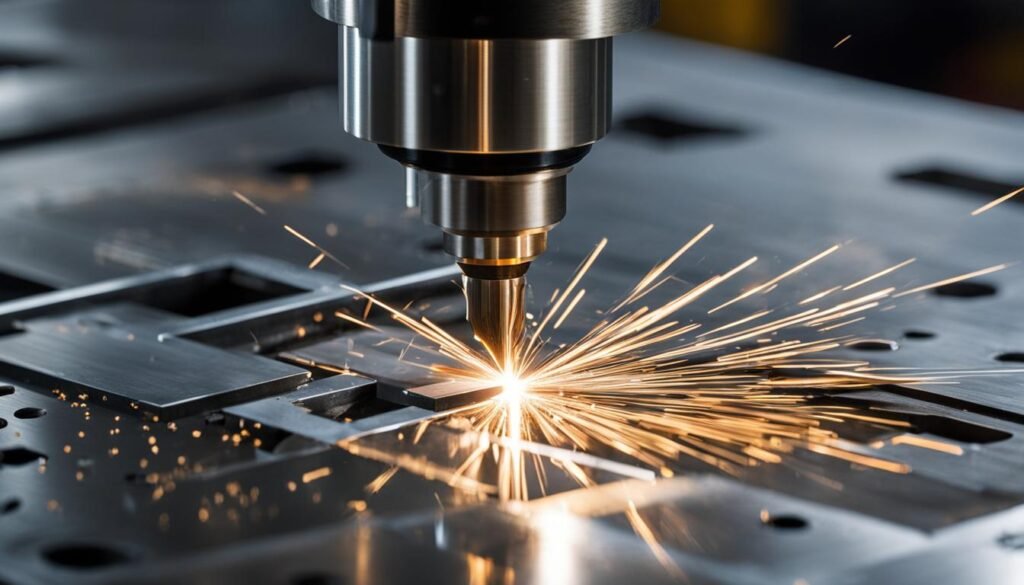
Components of CNC Cutting Programs
When it comes to CNC cutting programs, there are several key components that play a vital role in ensuring precise and efficient machining processes. Understanding these components is essential for manufacturers looking to optimize their CNC cutting programs and achieve high-quality results. Let’s take a closer look at the main components:
G-code
G-code is a programming language that serves as the backbone of CNC cutting programs. It contains a series of instructions that dictate the movements and operations of the machine, such as the speed, direction, and positioning of the cutting tool. G-code ensures that the machine follows the desired toolpath and accurately creates the intended shape and form of the component.
Toolpath Generation
Toolpath generation involves creating a path that the cutting tool will follow to shape the component. This process takes into account various factors, such as the geometry of the component, the type of cutting tool being used, and the desired level of precision. By generating efficient and optimized toolpaths, manufacturers can minimize machining time and maximize the accuracy of the final product.
Feedrate and Spindle Speed
Adjusting the feedrate and spindle speed settings is crucial for optimizing the performance of CNC cutting programs. The feedrate determines how fast the cutting tool moves along the toolpath, while the spindle speed controls the rotational speed of the cutting tool. Balancing these two factors is essential for achieving the desired cutting results while ensuring the longevity of the cutting tool.
Tool Compensation
Tool compensation accounts for any variations in tool size or positioning, ensuring that the machining process compensates for these differences. This is particularly important when working with tools that may wear down or when using multiple tools within the same program. Tool compensation ensures consistent and accurate machining results, even in the presence of tool wear or dimensional variations.
Steps to Create a CNC Cutting Program
Designing and modeling the desired component is the initial step in creating a CNC cutting program. This involves using software like CAD (Computer-Aided Design) to create a 3D model of the component. The design should be precise and detailed, taking into account all dimensions and specifications.
Once the design is complete, CAM (Computer-Aided Manufacturing) software comes into play. CAM software takes the 3D model and generates toolpaths, which outline the exact movements that the CNC machine needs to make to shape the component. It optimizes the program by analyzing factors like tool selection, cutting parameters, and material properties. CAM software allows for customization and fine-tuning, ensuring the program is tailored to achieve the desired results.
After the toolpaths are generated in CAM software, the next step is post-processing. Post-processing involves validating and optimizing the CNC cutting program for machine execution. This includes reviewing the toolpath, adjusting speed and feedrate settings, and making any necessary modifications to ensure the program runs smoothly. The post-processing phase is crucial for eliminating any potential errors or issues before the program is sent to the CNC machine for production.
| Step | Description |
|---|---|
| 1 | Design and model the desired component using CAD software. |
| 2 | Utilize CAM software to generate toolpaths based on the 3D model. |
| 3 | Perform post-processing to validate and optimize the CNC cutting program for machine execution. |
By following these steps, manufacturers can ensure the creation of a robust CNC cutting program that meets their specific requirements for precision, efficiency, and quality.
Best Practices for CNC Cutting Programs
When it comes to CNC cutting programs, there are several best practices that manufacturers can follow to optimize their processes and achieve high-quality results. From optimizing toolpaths to handling errors and staying up-to-date with improvements, here are some key practices to consider:
Optimization Techniques
One of the most important aspects of CNC cutting programs is optimizing toolpaths. By carefully planning and refining the toolpaths, manufacturers can reduce unnecessary movements and minimize cutting time, resulting in improved efficiency. Additionally, adjusting cutting parameters such as feedrate and spindle speed can further enhance performance and precision. Optimization techniques also include minimizing waste material and optimizing the use of cutting tools to reduce costs and increase productivity.
Error Handling and Troubleshooting
Handling errors is an essential part of CNC cutting programs. By implementing error handling mechanisms, manufacturers can identify and resolve common errors that may occur during the machining process. This includes monitoring the machine’s performance, implementing quality assurance measures, and having a systematic approach to troubleshooting. By promptly addressing errors, manufacturers can minimize downtime and ensure the smooth operation of their CNC cutting programs.
Updates and Improvements
To stay ahead in the field of CNC cutting programs, it is crucial to constantly update and improve the programs. Staying informed about the latest advancements in CNC cutting programming allows manufacturers to leverage new techniques and technologies that can enhance their processes. This includes utilizing the latest software updates, exploring new programming languages, and adopting emerging technologies such as machine learning and automation. By embracing updates and improvements, manufacturers can continuously enhance their CNC cutting programs and stay competitive in the industry.
| Best Practices for CNC Cutting Programs |
|---|
| Optimization Techniques |
| Error Handling and Troubleshooting |
| Updates and Improvements |
Case Study: Real-life Examples of CNC Cutting Programs
Real-life examples of CNC cutting programs can be found in various industries, including the automotive, aerospace, and medical sectors. These industries rely on CNC cutting programs to manufacture a wide range of components with precision and accuracy, ensuring high-quality finished products.
In the automotive industry, CNC cutting programs are used to create complex components such as gears, crankshafts, and engine blocks. These programs enable manufacturers to achieve the tight tolerances and intricate shapes required for optimal performance and efficiency in vehicles.
The aerospace industry also heavily relies on CNC cutting programs to manufacture critical components for aircraft. CNC cutting programs play a crucial role in shaping and forming parts such as turbine blades, wing sections, and landing gear components. The precision and repeatability provided by these programs are essential to ensure the safety and reliability of aircraft.
The medical industry also benefits greatly from CNC cutting programs. These programs are used to manufacture medical equipment and devices with high precision and accuracy. From surgical instruments to prosthetic limbs, CNC cutting programs enable manufacturers to produce intricate and customized components that meet the specific needs of patients and healthcare professionals.

These examples showcase the versatility and importance of CNC cutting programs across industries. By leveraging the power of automated machines and precise instructions, manufacturers can achieve exceptional results and meet the demanding requirements of their respective sectors.
Future Trends in CNC Cutting Programs
The field of CNC cutting programs is constantly evolving, with emerging technologies shaping the future of precision manufacturing. Two key trends that hold tremendous potential are machine learning and automation. These advancements aim to further enhance the efficiency and precision of CNC cutting processes, revolutionizing the manufacturing industry.

Machine Learning
Machine learning is a branch of artificial intelligence that enables machines to learn and improve from experience without being explicitly programmed. In the context of CNC cutting programs, machine learning algorithms can analyze vast amounts of data collected from previous machining processes to identify patterns and optimize performance. This allows manufacturers to achieve higher levels of precision, reduce errors, and enhance overall productivity.
Automation
Automation plays a crucial role in streamlining CNC cutting processes. By automating tasks such as tool changes, material handling, and quality control, manufacturers can significantly reduce production time and human error. Automation also enables continuous operation, resulting in increased productivity and cost-effectiveness. The integration of robots and advanced robotics systems further enhances the capabilities of automation in CNC cutting programs.
As these emerging technologies continue to evolve and mature, manufacturers can expect significant advancements in the field of CNC cutting programs. This includes improved machine learning algorithms, seamless integration with other advanced technologies like Internet of Things (IoT), and further automation of complex machining processes.
By embracing these future trends, manufacturers can unlock new levels of efficiency, accuracy, and productivity in CNC cutting programs, paving the way for the next generation of precision manufacturing.
CNC Machining and Engineering Services
When it comes to precision manufacturing, CNC machining and engineering services are essential for achieving high-quality results. These services provide manufacturers with comprehensive solutions for their machining needs, offering a range of capabilities and expertise.
CNC machining services encompass various processes, including turning, milling, drilling, and grinding, among others. These services utilize advanced CNC machines and technologies to produce components with impeccable precision and accuracy. Whether you need to create complex parts with intricate details or simple components with tight tolerances, CNC machining services can meet your requirements.
Moreover, engineering support is a crucial aspect of CNC machining services. Experienced engineers work closely with manufacturers to understand their specifications and design requirements. They provide valuable insights and recommendations to optimize the manufacturing process, improve component performance, and ensure cost-effectiveness. With engineering support, manufacturers can confidently produce components that meet the highest standards of quality and functionality.
| Advantages of CNC Machining Services |
|---|
|
Overall, CNC machining and engineering services provide manufacturers with the necessary expertise, technologies, and capabilities to achieve precision manufacturing. Whether you are in the automotive, aerospace, or any other industry, these services play a critical role in meeting your machining needs while ensuring optimal performance and quality.
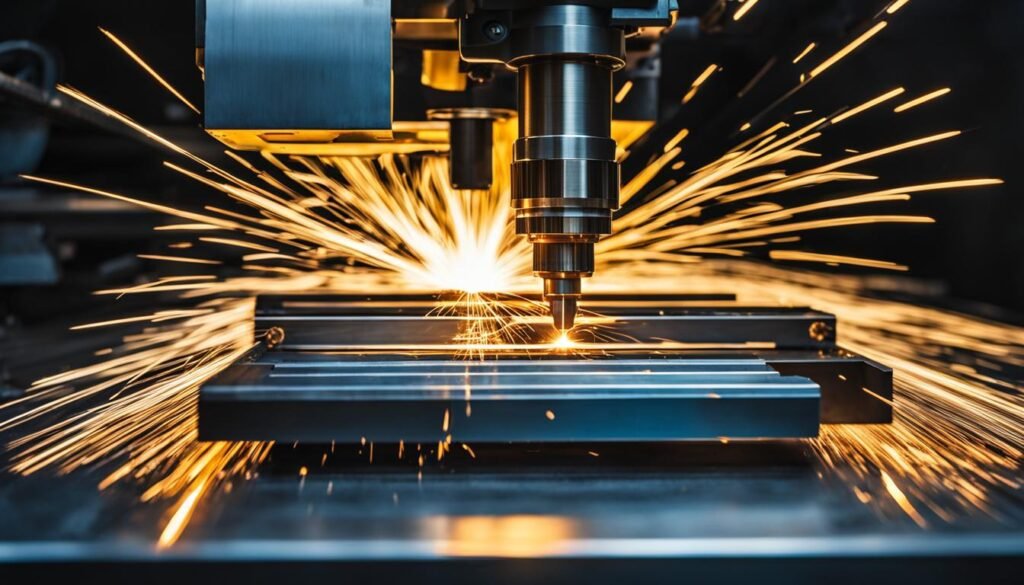
Advantages of CNC Machining Services
CNC machining services offer numerous benefits to manufacturers, providing them with a range of advantages that contribute to their success. Whether you are a small business or a large corporation, utilizing CNC machining services can help meet your specific requirements and enhance your manufacturing processes.
One of the key advantages of CNC machining services is the ability to provide custom machining solutions. With CNC machines, manufacturers have the flexibility to create components tailored to their exact specifications. This allows for greater precision and accuracy, ensuring that the final products meet the desired standards.
Additionally, CNC machining services offer flexible manufacturing capabilities. Manufacturers can easily adapt their production processes to accommodate changes in design or quantity requirements. This flexibility allows for efficient production planning and quicker turnaround times, ultimately improving overall productivity.
| Advantages of CNC Machining Services | Description |
|---|---|
| Custom Machining | Ability to create components tailored to exact specifications. |
| Flexible Manufacturing | Capability to adapt production processes to changes in design or quantity requirements. |
| Design Optimization | Expert suggestions for improving component performance and cost-effectiveness. |
Design optimization is another significant advantage of CNC machining services. Experienced professionals can offer expert suggestions to optimize the design of components, resulting in improved performance and cost-effectiveness. By leveraging their expertise, manufacturers can enhance their products and gain a competitive edge in the market.
In summary, CNC machining services provide manufacturers with custom machining solutions, flexible manufacturing capabilities, and design optimization opportunities. By leveraging these advantages, manufacturers can streamline their production processes, achieve higher precision and accuracy, and ultimately deliver superior products to their customers.
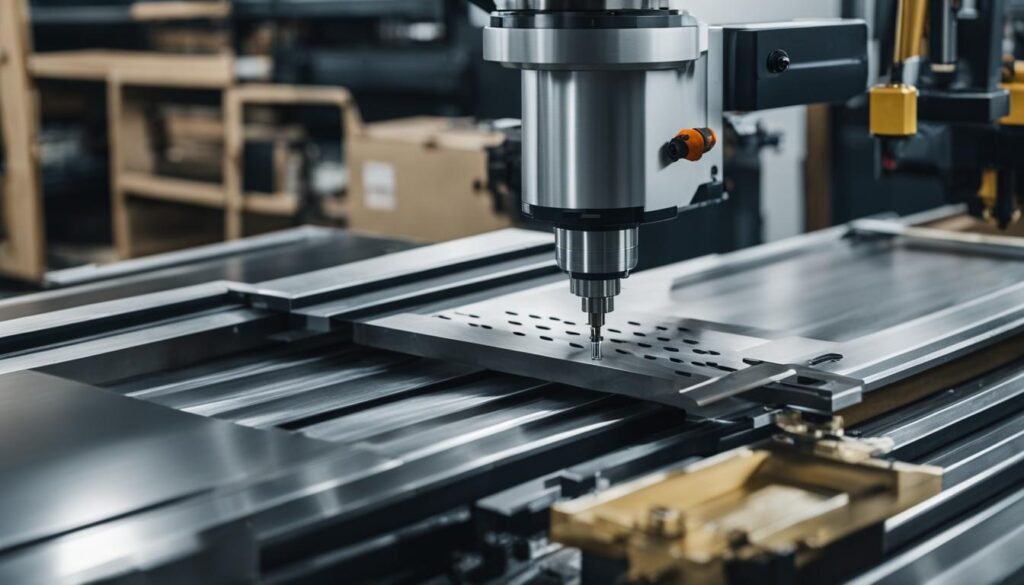
Materials for CNC Machining
CNC machining offers a versatile solution for manufacturing components using a wide range of materials. Whether you’re working with metals or plastics, CNC machining can deliver precise and high-quality results. The choice of material depends on the specific requirements of the component and the intended application. Let’s explore some commonly used materials in CNC machining.
Metal Machining
Metal machining is a fundamental aspect of CNC machining. It involves shaping and forming metallic components with precision. Here are some popular metal materials used in CNC machining:
| Material | Properties | Applications |
|---|---|---|
| Aluminum | Lightweight, excellent thermal and electrical conductivity, corrosion-resistant | Aerospace components, automotive parts, consumer electronics |
| Stainless Steel | High strength, excellent corrosion resistance | Medical equipment, food processing machinery, architectural components |
| Brass | Good machinability, attractive appearance | Plumbing fittings, musical instruments, decorative hardware |
Plastic Machining
Plastic machining is another common application of CNC machining, offering versatility and cost-effectiveness. Various engineering plastics can be machined using CNC techniques. Here are some examples:
- Acrylic: Transparent, lightweight, easy to shape. Ideal for displays, signage, and lighting fixtures.
- Nylon: High strength, excellent wear resistance. Widely used in gears, bearings, and structural parts.
- Polycarbonate: Impact-resistant, good optical clarity. Used in safety goggles, machine guards, and automotive components.
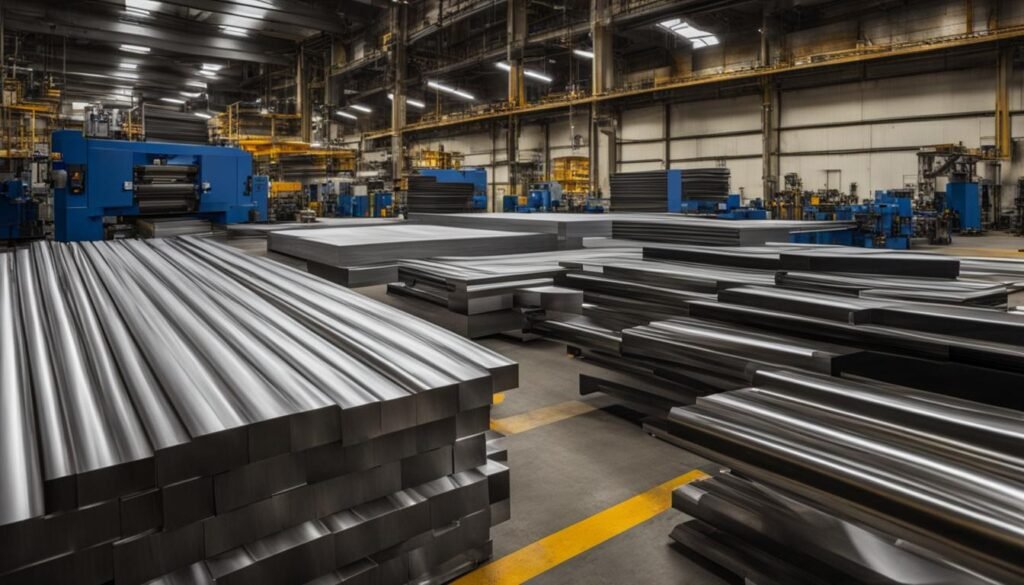
As you can see, CNC machining opens up a world of possibilities when it comes to material selection. Whether you need to create precise metal components or shape plastic parts with intricate details, CNC machining offers the flexibility and accuracy needed to bring your ideas to life.
Quality Control in CNC Machining
Quality control is an essential aspect of CNC machining to ensure that the final products meet the required specifications and maintain a high level of precision. Implementing effective quality assurance measures, performing thorough inspection processes, and maintaining tolerance control are key elements of ensuring the quality of CNC machining projects.
To begin with, quality assurance protocols are put in place to ensure that every step of the CNC machining process adheres to the defined standards. These protocols may include regular calibration of machines, verification of tooling and fixtures, and documentation of standard operating procedures. By following these protocols, manufacturers can minimize the risk of errors and deviations, ensuring consistent quality output.
Inspection processes are carried out at various stages of CNC machining to identify any deviations from the desired specifications. This can involve using measuring instruments such as calipers, micrometers, and coordinate measuring machines (CMMs) to verify dimensional accuracy. Visual inspections are also conducted to identify any surface defects or irregularities. These inspection processes ensure that any issues are identified early on and appropriate corrective actions are taken.
Table: Quality Control Measures in CNC Machining
| Quality Control Measure | Description |
|---|---|
| Regular Calibration | Periodic calibration of machines and measuring instruments to maintain accuracy. |
| Verification of Tooling and Fixtures | Ensuring proper functioning and alignment of tooling and fixtures used in the CNC machining process. |
| Documentation of Standard Operating Procedures | Creating and maintaining detailed documentation of standard operating procedures to ensure consistency and repeatability. |
| Dimensional Inspections | Using measuring instruments to verify dimensional accuracy and identify any deviations from specified tolerances. |
| Visual Inspections | Thorough visual inspections to identify any surface defects or irregularities that may affect the quality of the final product. |
“Effective quality control measures in CNC machining ensure that the final products meet the required specifications and maintain a high level of precision.”
Tolerance control is another crucial aspect of quality control in CNC machining. Tolerances define the permissible variations from the specified dimensions, and it is essential to maintain tight tolerances to ensure the functionality and fit of the final product. Through careful measurement and control of machining parameters such as tool geometry, feed rates, and spindle speeds, manufacturers can achieve the desired tolerances and meet the required specifications.
In summary, quality control measures play a vital role in ensuring the accuracy and precision of CNC machining processes. By implementing effective quality assurance protocols, conducting thorough inspections, and maintaining tolerance control, manufacturers can deliver high-quality products that meet customer expectations and comply with industry standards.
Conclusion
In conclusion, CNC cutting is a revolutionary technology that has transformed the field of precision manufacturing. By utilizing CNC cutting programs and following best practices, manufacturers can significantly enhance the efficiency, accuracy, and overall quality of their machining processes.
CNC cutting programs play a vital role in guiding automated machines to execute precise operations with consistency and excellence. They are essential for industries such as automotive, aerospace, and medical, where high-quality results are crucial. From G-code to toolpath generation, every component of CNC cutting programs contributes to achieving optimal performance and desired outcomes.
Creating CNC cutting programs involves a step-by-step process, starting from design and modeling to utilizing CAM software and post-processing. Following these steps ensures that the CNC cutting program is optimized for machine execution and delivers exceptional results.
Looking ahead, the future of CNC cutting programs promises further advancements driven by emerging technologies such as machine learning and automation. These technologies will lead to increased automation, improved machine learning algorithms, and integration with other advanced technologies, pushing the boundaries of precision manufacturing.
FAQ
What is CNC cutting?
CNC cutting, also known as Computer Numerical Control cutting, is a manufacturing process that utilizes automated machines to shape and form components with precision.
Why are CNC cutting programs important?
CNC cutting programs play a crucial role in guiding the machine to execute precise operations, ensuring consistent and high-quality results in industries such as automotive, aerospace, and medical.
What are the components of CNC cutting programs?
The components of CNC cutting programs include G-code, toolpath generation, feedrate and spindle speed settings, and tool compensation.
What are the steps to create a CNC cutting program?
Creating a CNC cutting program involves designing and modeling the component, using CAM software to generate toolpaths, and post-processing to finalize the program for machine execution.
How can CNC cutting programs be optimized?
CNC cutting programs can be optimized through techniques such as optimizing toolpaths, adjusting cutting parameters, and minimizing waste. Error handling and troubleshooting methods are also important in identifying and resolving common errors.
What are some real-life examples of CNC cutting programs?
CNC cutting programs are used in various industries to manufacture components such as gears, crankshafts, and medical equipment.
What is the future of CNC cutting programs?
The future of CNC cutting programs is shaped by emerging technologies such as machine learning and automation, aiming to enhance efficiency and precision in the machining processes.
What are CNC machining and engineering services?
CNC machining and engineering services provide manufacturers with comprehensive solutions for their machining needs, including CNC turning, milling, drilling, and grinding.
What are the advantages of CNC machining services?
CNC machining services offer custom machining, design optimization, fast lead times, and high-quality results, providing flexibility and improved performance.
What materials can be used for CNC machining?
CNC machining can be performed on a wide range of materials, including metals like aluminum, stainless steel, and brass, as well as various engineering plastics.
How important is quality control in CNC machining?
Quality control is essential in CNC machining to ensure that the final product meets the required specifications and maintains high standards of quality throughout the manufacturing process.
